TXDELAY3 Transmit delays for a matrix array
TXDELAY returns the transmit time delays for focused, plane or diverging beam patterns with a matrix array.
Contents
Syntax
DELAYS = TXDELAY3(X0,Y0,Z0,PARAM) returns the transmit time delays for a pressure field focused at the point (x0,y0,z0). If z0 is negative, then the point (x0,y0,z0) is a virtual source. The properties of the medium and array must be given in the structure PARAM (see below).
DELAYS = TXDELAY3([X01 X02],[Y01 Y02],[Z01 Z02],PARAM) returns the transmit time delays for a pressure field focused at the line specified by the two points (x01,y01,z01) and (x02,y02,z02).
DELAYS = TXDELAY3(PARAM,TILTx,TILTy) returns the transmit time delays for a tilted plane wave. TILTx is the tilt angle about the X-axis. TILTy is the tilt angle about the Y-axis. If TILTx = TILTy = 0, then the delays are 0.
DELAYS = TXDELAY3(PARAM,TILTx,TILTy,OMEGA) yields the transmit time delays for a diverging wave. The sector is characterized by the angular tilts and the solid angle OMEGA subtented by the rectangular aperture of the transducer. TILTx is the tilt angle about the X-axis. TILTy is the tilt angle about the Y-axis. OMEGA sets the amount of the field of view (in [0 2pi]). This syntax is for matrix arrays only, i.e. the element positions must form a plaid grid.
[DELAYS,PARAM] = TXDELAY3(...) updates the PARAM structure parameters including the default values. PARAM will also include PARAM.TXdelay, which is equal to DELAYS (in s).
[...] = TXDELAY3 (no input parameter) simulates a focused pressure field generated by a 3-MHz 32x32 matrix array (1st example below).
Units: X0, Y0 and Z0 must be in m; TILTx and TILTy must be in rad. OMEGA is in sr (steradian). DELAYS are in s.
The structure PARAM
PARAM is a structure that must contain the following fields:
- PARAM.elements: x- and y-coordinates of the element centers (in m, required). It MUST be a two-row matrix, with the 1st and 2nd rows containing the x and y coordinates, respectively.
- PARAM.width: element width, in the x-direction (in m, required)
- PARAM.height: element height, in the y-direction (in m, required)
- PARAM.c: longitudinal velocity (in m/s, default = 1540 m/s)
Notes
- NOTE #1: X-, Y-, and Z-axes
For a linear array, the X-axis is PARALLEL to the transducer and points from the first (leftmost) element to the last (rightmost) element (X = 0 at the CENTER of the transducer).
The Z-axis is PERPENDICULAR to the transducer and points downward (Z = 0 at the level of the transducer, Z increases as depth increases). See the figure below.
The Y-axis is is such that the coordinates are right-handed.
- NOTE #2: TILT angles
TILTx and TILTy (in radians) describe the tilt angles in the trigonometric direction.
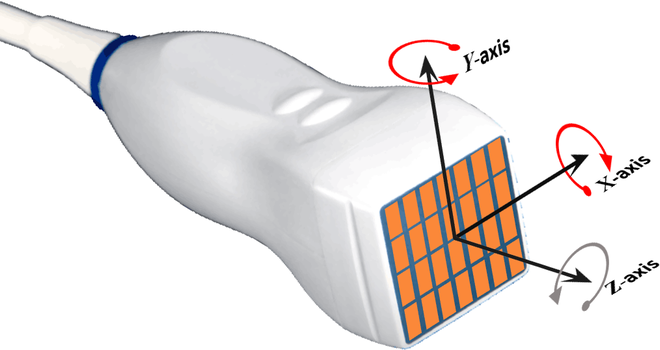
- NOTE #3: solid angle OMEGA
For a diverging wave with a matrix array, OMEGA describes the solid angle subtented by the rectangular aperture of the transducer.
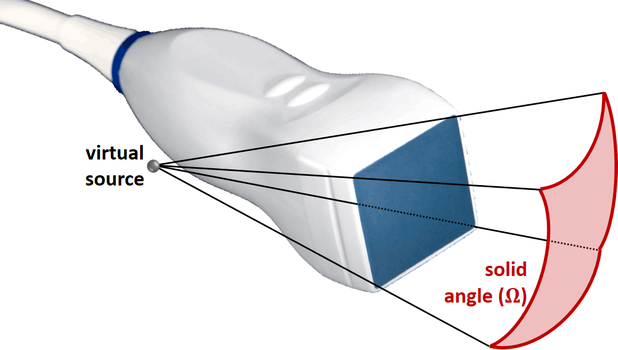
Example #1: 3-D focused pressure field with a matrix-array transducer
This example shows how to generate a three-dimensional focused pressure field with a matrix-array transducer.
Create a 3-MHz matrix array with 32x32 elements.
param = []; param.fc = 3e6; param.bandwidth = 70; param.width = 250e-6; param.height = 250e-6;
Specify the x- and y-coordinates of the elements.
pitch = 300e-6; % pitch (in m)
[xe,ye] = meshgrid(((1:32)-16.5)*pitch);
param.elements = [xe(:).'; ye(:).'];
Choose a focus point at xf = 0 mm, yf = -2 mm, zf = 30 mm.
xf = 0; yf = -2e-3; zf = 30e-3; % focus position (in m)
Obtain the corresponding transmit time delays with TXDELAY3.
txdel = txdelay3(xf,yf,zf,param); % in s
Check the elements and the delays with VIEWXDCR
p = viewxdcr(param); p.FaceVertexCData = txdel(:)*1e9; c = colorbar('SouthOutside'); c.Label.String = 'TX delays (ns)'; colormap([1-hot;hot]) title('32\times32-element matrix array')
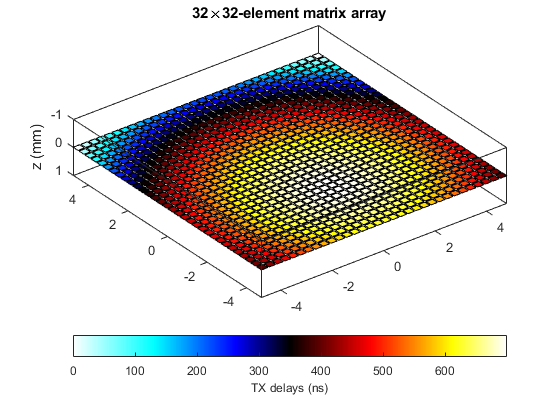
Simulate the pressure field by using PFIELD3.
First define a volume grid.
n = 32; x = linspace(-5e-3,5e-3,n); % (in m) y = linspace(-5e-3,5e-3,n); % (in m) z = linspace(0,6e-2,4*n); % (in m) [x,y,z] = meshgrid(x,y,z);
The function PFIELD3 yields the root-mean-square (RMS) pressure field.
RP = pfield3(x,y,z,txdel,param);
Display the acoustic pressure field and the element centers.
RPdB = 20*log10(RP/max(RP(:))); % convert to dB slice(x*1e2,y*1e2,z*1e2,RPdB,xf*1e2,yf*1e2,zf*1e2) shading flat colormap(hot), caxis([-20 0]) set(gca,'zdir','reverse'), axis equal alpha color % some transparency c = colorbar; c.YTickLabel{end} = '0 dB'; zlabel('[cm]') title('Focused wave - RMS pressure field') view(-80,40) hold on plot3(xe*1e2,ye*1e2,xe*0,'b.') hold off
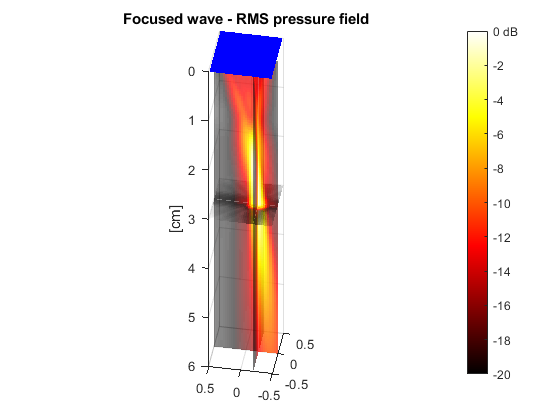
Example #2: 3-D diverging wave with a matrix array
This example shows how to generate a diverging pressure field with a matrix transducer.
Create a 3-MHz matrix array with 32x32 elements.
param = []; param.fc = 3e6; param.bandwidth = 70; param.width = 250e-6; param.height = 250e-6;
Specify the x- and y-coordinates of the elements.
pitch = 300e-6; % pitch (in m)
[xe,ye] = meshgrid(((1:32)-16.5)*pitch);
param.elements = [xe(:).'; ye(:).'];
Define a transmit apodization.
h = cos(linspace(-pi/4,pi/4,32)); h = h'*h; param.TXapodization = h(:);
Generate the transmit time delays for a diverging wave with TXDELAY3.
tiltX = 10/180*pi; % tilt angle about the X-axis (in rad) tiltY = 10/180*pi; % tilt angle about the Y-axis (in rad) omega = 30/180*pi; % solid angle (in sr) txdel = txdelay3(param,tiltX,tiltY,omega); % in s
Check the elements and the delays with VIEWXDCR
delete(gcf); % delete the current figure p = viewxdcr(param); p.FaceVertexCData = txdel(:)*1e6; c = colorbar('SouthOutside'); c.Label.String = 'TX delays (ms)'; colormap([1-hot;hot]) title('32\times32-element matrix array')

Simulate the pressure field by using PFIELD3.
First define the x-, y-, z-coordinates of the ROI:
x = linspace(-4e-2,4e-2,200); y = x; z = linspace(0,10e-2,200);
Obtain the RMS pressure field on the azimuthal plane:
[xaz,zaz] = meshgrid(x,z); yaz = zeros(size(xaz)); Paz = pfield3(xaz,yaz,zaz,txdel,param);
Obtain the RMS pressure field on the elevation plane:
[yel,zel] = meshgrid(y,z); xel = zeros(size(yel)); Pel = pfield3(xel,yel,zel,txdel,param);
Obtain the RMS pressure field on some parallel planes:
[xfo,yfo] = meshgrid(x,y); zfo1 = ones(size(xfo))*3e-2; zfo2 = ones(size(xfo))*5e-2; zfo3 = ones(size(xfo))*7e-2; Pfo1 = pfield3(xfo,yfo,zfo1,txdel,param); Pfo2 = pfield3(xfo,yfo,zfo2,txdel,param); Pfo3 = pfield3(xfo,yfo,zfo3,txdel,param);
Display the acoustic pressure field.
Pmax = max(max(Paz(:)),max(Pel(:))); surf(xaz*1e2,yaz*1e2,zaz*1e2,20*log10(Paz/Pmax)), shading flat hold on surf(xel*1e2,yel*1e2,zel*1e2,20*log10(Pel/Pmax)), shading flat surf(xfo*1e2,yfo*1e2,zfo1*1e2,20*log10(Pfo1/Pmax)), shading flat surf(xfo*1e2,yfo*1e2,zfo2*1e2,20*log10(Pfo2/Pmax)), shading flat surf(xfo*1e2,yfo*1e2,zfo3*1e2,20*log10(Pfo3/Pmax)), shading flat % Display the elements plot3(xe*1e2,ye*1e2,xe*0,'k.') hold off % Fine-tune the figure: axis equal zlabel('[cm]') set(gca,'ZDir','reverse') title('3-D diverging wave ([-20,0] dB)') caxis([-20 0]) alpha color colormap(flipud([hot;1-hot])) xlabel('x') ylabel('y') view(-25,20)
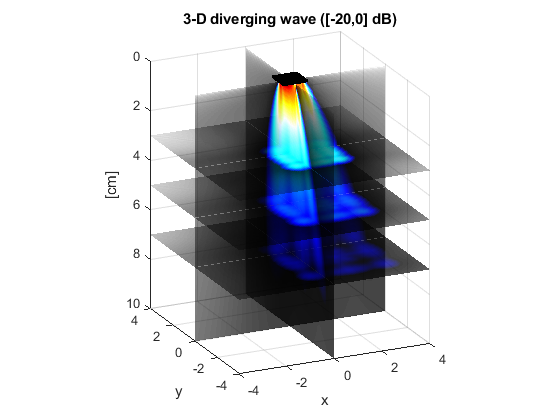
See also
das3, pfield3, simus3, txdelay, viewxdcr
About the author
Damien Garcia, Eng., Ph.D. INSERM researcher Creatis, University of Lyon, France
websites: BioméCardio, MUST
Date modified